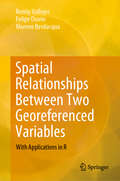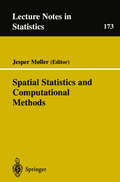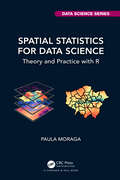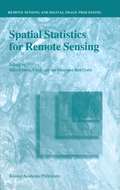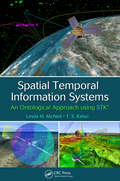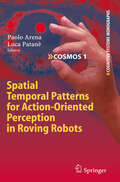- Table View
- List View
Spatial Reasoning Puzzles That Make Kids Think!: Grades 6-8
by Jeffrey J. WankoSpatial Reasoning Puzzles That Make Kids Think! engages even the most reluctant math learner. In this fun and challenging book, students must conquer four types of logical and spatial reasoning puzzles (Slitherlink, Hashiwokakero, Masyu, and Yajilin). The rules for each type of puzzle are very different, but easy to understand. The challenge is for students to apply their critical thinking skills to new situations and develop new strategies for solving each puzzle. Teacher support is provided for solving the puzzles and also for helping students to create puzzles of their own. Students will be begging for more of these unique spatial reasoning puzzles!Grades 6-8
Spatial Reasoning Puzzles That Make Kids Think!: Grades 6-8
by Jeffrey J. WankoSpatial Reasoning Puzzles That Make Kids Think! engages even the most reluctant math learner. In this fun and challenging book, students must conquer four types of logical and spatial reasoning puzzles (Slitherlink, Hashiwokakero, Masyu, and Yajilin). The rules for each type of puzzle are very different, but easy to understand. The challenge is for students to apply their critical thinking skills to new situations and develop new strategies for solving each puzzle. Teacher support is provided for solving the puzzles and also for helping students to create puzzles of their own. Students will be begging for more of these unique spatial reasoning puzzles!Grades 6-8
Spatial Relationships Between Two Georeferenced Variables: With Applications in R
by Ronny Vallejos Felipe Osorio Moreno BevilacquaThis book offers essential, systematic information on the assessment of the spatial association between two processes from a statistical standpoint. Divided into eight chapters, the book begins with preliminary concepts, mainly concerning spatial statistics. The following seven chapters focus on the methodologies needed to assess the correlation between two or more processes; from theory introduced 35 years ago, to techniques that have only recently been published. Furthermore, each chapter contains a section on R computations to explore how the methodology works with real data. References and a list of exercises are included at the end of each chapter. The assessment of the correlation between two spatial processes has been tackled from several different perspectives in a variety of applications fields. In particular, the problem of testing for the existence of spatial association between two georeferenced variables is relevant for posterior modeling and inference. One evident application in this context is the quantification of the spatial correlation between two images (processes defined on a rectangular grid in a two-dimensional space). From a statistical perspective, this problem can be handled via hypothesis testing, or by using extensions of the correlation coefficient. In an image-processing framework, these extensions can also be used to define similarity indices between images.
Spatial Sampling with R (Chapman & Hall/CRC The R Series)
by Dick J. BrusScientific research often starts with data collection. However, many researchers pay insufficient attention to this first step in their research. The author, researcher at Wageningen University and Research, often had to conclude that the data collected by fellow researchers were suboptimal, or in some cases even unsuitable for their aim. One reason is that sampling is frequently overlooked in statistics courses. Another reason is the lack of practical textbooks on sampling. Numerous books have been published on the statistical analysis and modelling of data using R, but to date no book has been published in this series on how these data can best be collected. This book fills this gap. Spatial Sampling with R presents an overview of sampling designs for spatial sample survey and monitoring. It shows how to implement the sampling designs and how to estimate (sub)population- and space-time parameters in R. Key features Describes classical, basic sampling designs for spatial survey, as well as recently developed, advanced sampling designs and estimators Presents probability sampling designs for estimating parameters for a (sub)population, as well as non-probability sampling designs for mapping Gives comprehensive overview of model-assisted estimators Covers Bayesian approach to sampling design Illustrates sampling designs with surveys of soil organic carbon, above-ground biomass, air temperature, opium poppy Explains integration of wall-to-wall data sets (e.g. remote sensing images) and sample data Data and R code available on github Exercises added making the book suitable as a textbook for students The target group of this book are researchers and practitioners of sample surveys, as well as students in environmental, ecological, agricultural science or any other science in which knowledge about a population of interest is collected through spatial sampling. This book helps to implement proper sampling designs, tailored to their problems at hand, so that valuable data are collected that can be used to answer the research questions.
Spatial Sampling with R (Chapman & Hall/CRC The R Series)
by Dick J. BrusScientific research often starts with data collection. However, many researchers pay insufficient attention to this first step in their research. The author, researcher at Wageningen University and Research, often had to conclude that the data collected by fellow researchers were suboptimal, or in some cases even unsuitable for their aim. One reason is that sampling is frequently overlooked in statistics courses. Another reason is the lack of practical textbooks on sampling. Numerous books have been published on the statistical analysis and modelling of data using R, but to date no book has been published in this series on how these data can best be collected. This book fills this gap. Spatial Sampling with R presents an overview of sampling designs for spatial sample survey and monitoring. It shows how to implement the sampling designs and how to estimate (sub)population- and space-time parameters in R. Key features Describes classical, basic sampling designs for spatial survey, as well as recently developed, advanced sampling designs and estimators Presents probability sampling designs for estimating parameters for a (sub)population, as well as non-probability sampling designs for mapping Gives comprehensive overview of model-assisted estimators Covers Bayesian approach to sampling design Illustrates sampling designs with surveys of soil organic carbon, above-ground biomass, air temperature, opium poppy Explains integration of wall-to-wall data sets (e.g. remote sensing images) and sample data Data and R code available on github Exercises added making the book suitable as a textbook for students The target group of this book are researchers and practitioners of sample surveys, as well as students in environmental, ecological, agricultural science or any other science in which knowledge about a population of interest is collected through spatial sampling. This book helps to implement proper sampling designs, tailored to their problems at hand, so that valuable data are collected that can be used to answer the research questions.
Spatial Similarity Relations in Multi-scale Map Spaces
by Haowen Yan Jonathan LiHow does one determine how similar two maps are? This book aims at the theory of spatial similarity relations and its application in automated map generalization, including the definitions, classification and features of spatial similarity relations. Included also are calculation models of spatial similarity relations between arbitrary individual objects and between arbitrary object groups, and the application of the theory in the automation of the algorithms and procedures in map generalization.
Spatial Socio-econometric Modeling: A Low-Code Toolkit for Spatial Data Science and Interactive Visualizations Using R (Springer Texts in Social Sciences)
by Manuel S. González CanchéWith the primary goal of expanding access to spatial data science tools, this book offers dozens of minimal or low-code functions and tutorials designed to ease the implementation of fully reproducible Spatial Socio-Econometric Modeling (SSEM) analyses. Designed as a University of Pennsylvania Ph.D. level course for sociologists, political scientists, urban planners, criminologists, and data scientists, this textbook equips social scientists with all concepts, explanations, and functions required to strengthen their data storytelling. It specifically provides social scientists with a comprehensive set of open-access minimal code tools to:•Identify and access place-based longitudinal and cross-sectional data sources and formats•Conduct advanced data management, including crosswalks, joining, and matching•Fully connect social network analyses with geospatial statistics•Formulate research questions designed to account for place-based factors in model specification and assess their relevance compared to individual- or unit-level indicators•Estimate distance measures across units that follow road network paths •Create sophisticated and interactive HTML data visualizations cross-sectionally or longitudinally, to strengthen research storytelling capabilities•Follow best practices for presenting spatial analyses, findings, and implications•Master theories on neighborhood effects, equality of opportunity, and geography of (dis)advantage that undergird SSEM applications and methods•Assess multicollinearity issues via machine learning that may affect coefficients' estimates and guide the identification of relevant predictors•Strategize how to address feedback loops by using SSEM as an identification framework that can be merged with standard quasi-experimental techniques like propensity score models, instrumental variables, and difference in differences•Expand the SSEM analyses to connections that emerge via social interactions, such as co-authorship and advice networks, or any form of relational dataThe applied nature of the book along with the cost-free, multi-operative R software makes the usability and applicability of this textbook worldwide.
Spatial Statistical Methods for Geography
by Peter A. RogersonThis accessible new textbook offers a straightforward introduction to doing spatial statistics. Grounded in real world examples, it shows you how to extend traditional statistical methods for use with spatial data. The book assumes basic mathematical and statistics knowledge but also provides a handy refresher guide, so that you can develop your understanding and progress confidently. It also: · Equips you with the tools to both interpret and apply spatial statistical methods · Engages with the unique considerations that apply when working with geographic data · Helps you build your knowledge of key spatial statistical techniques, such as methods of geographic cluster detection.
Spatial Statistical Methods for Geography
by Peter A. RogersonThis accessible new textbook offers a straightforward introduction to doing spatial statistics. Grounded in real world examples, it shows you how to extend traditional statistical methods for use with spatial data. The book assumes basic mathematical and statistics knowledge but also provides a handy refresher guide, so that you can develop your understanding and progress confidently. It also: · Equips you with the tools to both interpret and apply spatial statistical methods · Engages with the unique considerations that apply when working with geographic data · Helps you build your knowledge of key spatial statistical techniques, such as methods of geographic cluster detection.
Spatial Statistical Methods for Geography
by Peter A. RogersonThis accessible new textbook offers a straightforward introduction to doing spatial statistics. Grounded in real world examples, it shows you how to extend traditional statistical methods for use with spatial data. The book assumes basic mathematical and statistics knowledge but also provides a handy refresher guide, so that you can develop your understanding and progress confidently. It also: · Equips you with the tools to both interpret and apply spatial statistical methods · Engages with the unique considerations that apply when working with geographic data · Helps you build your knowledge of key spatial statistical techniques, such as methods of geographic cluster detection.
Spatial Statistics (Wiley Series in Probability and Statistics #575)
by Brian D. RipleyThe Wiley-Interscience Paperback Series consists of selected books that have been made more accessible to consumers in an effort to increase global appeal and general circulation. With these new unabridged softcover volumes, Wiley hopes to extend the lives of these works by making them available to future generations of statisticians, mathematicians, and scientists. "Books such as this that bring together, clarify, and summarize recent research can lead to a great increase of interest in the area. . . . a major achievement in describing many aspects of spatial data and discussing, with examples, different methods of analysis." –Royal Statistical Society "Dr. Ripley’s book is an excellent survey of the spatial statistical methodology. It is very well illustrated with examples [that] give a clear view of the wide scope of the subject, the way in which techniques often have to be tailored to particular applications, and the different sorts of spatial data that arise." –The Bulletin of the London Mathematics Society Spatial Statistics provides a comprehensive guide to the analysis of spatial data. Each chapter covers a particular data format and the associated class of problems, introducing theory, giving computational suggestions, and providing examples. Methods are illustrated by computer-drawn figures. The book serves as an introduction to this rapidly growing research area for mathematicians and statisticians, and as a reference to new computer methods for researchers in ecology, geology, archaeology, and the earth sciences.
Spatial Statistics and Computational Methods (Lecture Notes in Statistics #173)
by Jesper MøllerThis volume shows how sophisticated spatial statistical and computational methods apply to a range of problems of increasing importance for applications in science and technology. It introduces topics of current interest in spatial and computational statistics, which should be accessible to postgraduate students as well as to experienced statistical researchers.
Spatial Statistics and Modeling (Springer Series in Statistics)
by Carlo Gaetan Xavier GuyonSpatial statistics are useful in subjects as diverse as climatology, ecology, economics, environmental and earth sciences, epidemiology, image analysis and more. This book covers the best-known spatial models for three types of spatial data: geostatistical data (stationarity, intrinsic models, variograms, spatial regression and space-time models), areal data (Gibbs-Markov fields and spatial auto-regression) and point pattern data (Poisson, Cox, Gibbs and Markov point processes). The level is relatively advanced, and the presentation concise but complete. The most important statistical methods and their asymptotic properties are described, including estimation in geostatistics, autocorrelation and second-order statistics, maximum likelihood methods, approximate inference using the pseudo-likelihood or Monte-Carlo simulations, statistics for point processes and Bayesian hierarchical models. A chapter is devoted to Markov Chain Monte Carlo simulation (Gibbs sampler, Metropolis-Hastings algorithms and exact simulation).A large number of real examples are studied with R, and each chapter ends with a set of theoretical and applied exercises. While a foundation in probability and mathematical statistics is assumed, three appendices introduce some necessary background. The book is accessible to senior undergraduate students with a solid math background and Ph.D. students in statistics. Furthermore, experienced statisticians and researchers in the above-mentioned fields will find the book valuable as a mathematically sound reference. This book is the English translation of Modélisation et Statistique Spatiales published by Springer in the series Mathématiques & Applications, a series established by Société de Mathématiques Appliquées et Industrielles (SMAI).
Spatial Statistics and Spatio-Temporal Data: Covariance Functions and Directional Properties (Wiley Series In Probability And Statistics Ser. #878)
by Michael ShermanIn the spatial or spatio-temporal context, specifying the correct covariance function is fundamental to obtain efficient predictions, and to understand the underlying physical process of interest. This book focuses on covariance and variogram functions, their role in prediction, and appropriate choice of these functions in applications. Both recent and more established methods are illustrated to assess many common assumptions on these functions, such as, isotropy, separability, symmetry, and intrinsic correlation. After an extensive introduction to spatial methodology, the book details the effects of common covariance assumptions and addresses methods to assess the appropriateness of such assumptions for various data structures. Key features: An extensive introduction to spatial methodology including a survey of spatial covariance functions and their use in spatial prediction (kriging) is given. Explores methodology for assessing the appropriateness of assumptions on covariance functions in the spatial, spatio-temporal, multivariate spatial, and point pattern settings. Provides illustrations of all methods based on data and simulation experiments to demonstrate all methodology and guide to proper usage of all methods. Presents a brief survey of spatial and spatio-temporal models, highlighting the Gaussian case and the binary data setting, along with the different methodologies for estimation and model fitting for these two data structures. Discusses models that allow for anisotropic and nonseparable behaviour in covariance functions in the spatial, spatio-temporal and multivariate settings. Gives an introduction to point pattern models, including testing for randomness, and fitting regular and clustered point patterns. The importance and assessment of isotropy of point patterns is detailed. Statisticians, researchers, and data analysts working with spatial and space-time data will benefit from this book as well as will graduate students with a background in basic statistics following courses in engineering, quantitative ecology or atmospheric science.
Spatial Statistics and Spatio-Temporal Data: Covariance Functions and Directional Properties (Wiley Series in Probability and Statistics #878)
by Michael ShermanIn the spatial or spatio-temporal context, specifying the correct covariance function is fundamental to obtain efficient predictions, and to understand the underlying physical process of interest. This book focuses on covariance and variogram functions, their role in prediction, and appropriate choice of these functions in applications. Both recent and more established methods are illustrated to assess many common assumptions on these functions, such as, isotropy, separability, symmetry, and intrinsic correlation. After an extensive introduction to spatial methodology, the book details the effects of common covariance assumptions and addresses methods to assess the appropriateness of such assumptions for various data structures. Key features: An extensive introduction to spatial methodology including a survey of spatial covariance functions and their use in spatial prediction (kriging) is given. Explores methodology for assessing the appropriateness of assumptions on covariance functions in the spatial, spatio-temporal, multivariate spatial, and point pattern settings. Provides illustrations of all methods based on data and simulation experiments to demonstrate all methodology and guide to proper usage of all methods. Presents a brief survey of spatial and spatio-temporal models, highlighting the Gaussian case and the binary data setting, along with the different methodologies for estimation and model fitting for these two data structures. Discusses models that allow for anisotropic and nonseparable behaviour in covariance functions in the spatial, spatio-temporal and multivariate settings. Gives an introduction to point pattern models, including testing for randomness, and fitting regular and clustered point patterns. The importance and assessment of isotropy of point patterns is detailed. Statisticians, researchers, and data analysts working with spatial and space-time data will benefit from this book as well as will graduate students with a background in basic statistics following courses in engineering, quantitative ecology or atmospheric science.
Spatial Statistics for Data Science: Theory and Practice with R (Chapman & Hall/CRC Data Science Series)
by Paula MoragaSpatial data is crucial to improve decision-making in a wide range of fields including environment, health, ecology, urban planning, economy, and society. Spatial Statistics for Data Science: Theory and Practice with R describes statistical methods, modeling approaches, and visualization techniques to analyze spatial data using R. The book provides a comprehensive overview of the varying types of spatial data, and detailed explanations of the theoretical concepts of spatial statistics, alongside fully reproducible examples which demonstrate how to simulate, describe, and analyze spatial data in various applications. Combining theory and practice, the book includes real-world data science examples such as disease risk mapping, air pollution prediction, species distribution modeling, crime mapping, and real state analyses. The book utilizes publicly available data and offers clear explanations of the R code for importing, manipulating, analyzing, and visualizing data, as well as the interpretation of the results. This ensures contents are easily accessible and fully reproducible for students, researchers, and practitioners. Key Features: Describes R packages for retrieval, manipulation, and visualization of spatial data Offers a comprehensive overview of spatial statistical methods including spatial autocorrelation, clustering, spatial interpolation, model-based geostatistics, and spatial point processes Provides detailed explanations on how to fit and interpret Bayesian spatial models using the integrated nested Laplace approximation (INLA) and stochastic partial differential equation (SPDE) approaches
Spatial Statistics for Data Science: Theory and Practice with R (Chapman & Hall/CRC Data Science Series)
by Paula MoragaSpatial data is crucial to improve decision-making in a wide range of fields including environment, health, ecology, urban planning, economy, and society. Spatial Statistics for Data Science: Theory and Practice with R describes statistical methods, modeling approaches, and visualization techniques to analyze spatial data using R. The book provides a comprehensive overview of the varying types of spatial data, and detailed explanations of the theoretical concepts of spatial statistics, alongside fully reproducible examples which demonstrate how to simulate, describe, and analyze spatial data in various applications. Combining theory and practice, the book includes real-world data science examples such as disease risk mapping, air pollution prediction, species distribution modeling, crime mapping, and real state analyses. The book utilizes publicly available data and offers clear explanations of the R code for importing, manipulating, analyzing, and visualizing data, as well as the interpretation of the results. This ensures contents are easily accessible and fully reproducible for students, researchers, and practitioners. Key Features: Describes R packages for retrieval, manipulation, and visualization of spatial data Offers a comprehensive overview of spatial statistical methods including spatial autocorrelation, clustering, spatial interpolation, model-based geostatistics, and spatial point processes Provides detailed explanations on how to fit and interpret Bayesian spatial models using the integrated nested Laplace approximation (INLA) and stochastic partial differential equation (SPDE) approaches
Spatial Statistics for Remote Sensing (Remote Sensing and Digital Image Processing #1)
by Ben Gorte A. Stein Freek D. Van Der MeerThis book is a collection of papers on spatial statistics for remote sensing. The book emerges from a study day that was organized in 1996 at the International Institute for Aerospace Survey and Earth Sciences, ITC, in Enschede, The Netherlands. It was by several means a memorable event. The beautiful new building, according to a design by the famous modern Dutch architect Max van Huet was just opened, and this workshop was the first to take place there. Of course, much went wrong during the workshop, in particular as the newest electronic equipment regularly failed. But the workshop attrackted more than hundred attendants, and was generally well received. The results of the workshop have been published in Stein et al. (1998). The aim of the workshop was to address issues of spatial statistics for remote sensing. The ITC has a long history on collecting and analyzing satellite and other remote sensing data, but its involvement into spatial statistics is of a more recent date. Uncertainties in remote sensing images and the large amounts of data in many spectral bands are now considered to be of such an impact that it requires a separate approach from a statistical point of view. To quote from the justification of the study day, we read: Modern communication means such as remote sensing require an advanced use of collected data. Satellites collect data with different resolution on different spectral bands.
Spatial Statistics: Methodological Aspects and Applications (Lecture Notes in Statistics #159)
by Marc MooreThis volume contains presentations by eminent researchers: Statistical Inference for Spatial Processes; Image Analysis; Applications of Spatial Statistics in Earth, Environmental, and Health Sciences; and Statistics of Brain Mapping. They range from asymptotic considerations for spatial processes to practical considerations related to particular applications including important methodological aspects. Many contributions concern image analysis, mainly images related to brain mapping.
Spatial Stochastic Processes: A Festschrift in Honor of Ted Harris on his Seventieth Birthday (Progress in Probability #19)
by K.S. Alexander J.C. WatkinsThis volume has been created in honor of the seventieth birthday of Ted Harris, which was celebrated on January 11th, 1989. The papers rep resent the wide range of subfields of probability theory in which Ted has made profound and fundamental contributions. This breadth in Ted's research complicates the task of putting together in his honor a book with a unified theme. One common thread noted was the spatial, or geometric, aspect of the phenomena Ted investigated. This volume has been organized around that theme, with papers covering four major subject areas of Ted's research: branching processes, percola tion, interacting particle systems, and stochastic flows. These four topics do not· exhaust his research interests; his major work on Markov chains is commemorated in the standard technology "Harris chain" and "Harris recurrent" . The editors would like to take this opportunity to thank the speakers at the symposium and the contributors to this volume. Their enthusi astic support is a tribute to Ted Harris. We would like to express our appreciation to Annette Mosley for her efforts in typing the manuscripts and to Arthur Ogawa for typesetting the volume. Finally, we gratefully acknowledge the National Science Foundation and the University of South ern California for their financial support.
Spatial Structure and the Microcomputer: Selected Mathematical Techniques (Computer Science Series)
by A.N. Barrett Alan L. MackaySpatial Synthesis: Computational Social Science and Humanities (Human Dynamics in Smart Cities)
by Xinyue Ye Hui LinThis book describes how powerful computing technology, emerging big and open data sources, and theoretical perspectives on spatial synthesis have revolutionized the way in which we investigate social sciences and humanities. It summarizes the principles and applications of human-centered computing and spatial social science and humanities research, thereby providing fundamental information that will help shape future research. The book illustrates how big spatiotemporal socioeconomic data facilitate the modelling of individuals’ economic behavior in space and time and how the outcomes of such models can reveal information about economic trends across spatial scales. It describes how spatial social science and humanities research has shifted from a data-scarce to a data-rich environment. The chapters also describe how a powerful analytical framework for identifying space-time research gaps and frontiers is fundamental to comparative study of spatiotemporal phenomena, and how research topics have evolved from structure and function to dynamic and predictive. As such this book provides an interesting read for researchers, students and all those interested in computational and spatial social sciences and humanities.
Spatial Temporal Information Systems: An Ontological Approach using STK
by Linda M. McNeil T.S. KelsoDesigned to be a high-level, approachable resource for engineers who need further insight into spatial temporal information systems from an ontological perspective, Spatial Temporal Information Systems: An Ontological Approach using STK explains the dynamics of objects interaction from signal analysis to trajectory design, spatial modeling, and oth
Spatial Temporal Patterns for Action-Oriented Perception in Roving Robots (Cognitive Systems Monographs #1)
by Paolo Arena Luca PatanèThe basic principles guiding sensing, perception and action in bio systems seem to rely on highly organised spatial-temporal dynamics. In fact, all biological senses, (visual, hearing, tactile, etc.) process signals coming from different parts distributed in space and also show a complex time evolution. As an example, mammalian retina performs a parallel representation of the visual world embodied into layers, each of which r- resents a particular detail of the scene. These results clearly state that visual perception starts at the level of the retina, and is not related uniquely to the higher brain centres. Although vision remains the most useful sense guiding usual actions, the other senses, ?rst of all hearing but also touch, become essential particularly in cluttered conditions, where visual percepts are somehow obscured by environment conditions. Ef?cient use of hearing can be learnt from acoustic perception in animals/insects, like crickets, that use this ancient sense more than all the others, to perform a vital function, like mating.
Spatial Tessellations: Concepts and Applications of Voronoi Diagrams (Wiley Series in Probability and Statistics #501)
by Atsuyuki Okabe Barry Boots Kokichi Sugihara Sung Nok ChiuSpatial data analysis is a fast growing area and Voronoi diagrams provide a means of naturally partitioning space into subregions to facilitate spatial data manipulation, modelling of spatial structures, pattern recognition and locational optimization. With such versatility, the Voronoi diagram and its relative, the Delaunay triangulation, provide valuable tools for the analysis of spatial data. This is a rapidly growing research area and in this fully updated second edition the authors provide an up-to-date and comprehensive unification of all the previous literature on the subject of Voronoi diagrams. Features: * Expands on the highly acclaimed first edition * Provides an up-to-date and comprehensive survey of the existing literature on Voronoi diagrams * Includes a useful compendium of applications * Contains an extensive bibliography A wide range of applications is discussed, enabling this book to serve as an important reference volume on this topic. The text will appeal to students and researchers studying spatial data in a number of areas, in particular, applied probability, computational geometry, and Geographic Information Science (GIS). This book will appeal equally to those whose interests in Voronoi diagrams are theoretical, practical or both.

